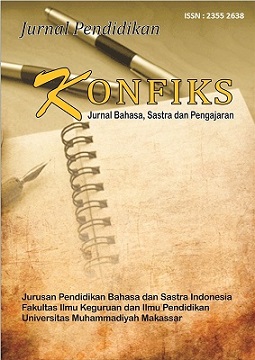RELIGIOUS VALUES OF THE SONG “MARS PUSAT MA’HAD AL-JAMI’AH”: RIFFATERRE’S SEMIOTIC ANALYSIS
DOI:
https://doi.org/10.26618/konfiks.v12i2.18640Keywords:
institutional mars, Qur’anic generation, religious values, Riffaterre semiotics, syi’ar IslamAbstract
The Mars Pusat Ma’had al-Jâmi’ah song is a symbolic representation of the institutional identity of the Pusat Ma’had al-Jâmi’ah at the State Islamic University of Maulana Malik Ibrahim Malang. This song not only expresses institutional spirit but also illustrates a harmonious integration of Javanese cultural elements and Islamic religious values. This study aims to explore the religious values embedded in the song’s lyrics and uncover their implicit meanings using Riffaterre’s semiotic theory. The research employed a qualitative descriptive method with data collected through intensive reading and textual annotation. Analysis followed the Miles, Huberman, and Saldana model, involving data collection, condensation, display, and conclusion drawing. The results reveal that the song serves not only as an aesthetic expression but also as an ideological and educational medium. The matrix or underlying meaning lies in the Ma’had’s mission to nurture a Qur’anic generation. This is reflected through two dominant models: the development of Qur’anic character and the reinforcement of Islamic symbols (syi’ar Islam) in social contexts. Key religious values identified include unwavering faith, personal and social piety, and sincere devotion to Islamic teachings reflected in real-life actions. Additionally, the song acts as a medium for internalizing spiritual values and affirming the cultural and religious identity of pesantren-based education. The findings imply that institutional mars songs hold potential as effective instruments for character development and the transmission of Islamic values, particularly in strengthening the cultural-spiritual identity within Islamic educational institutions.
References
Amin, A. R. (2014). Sistem Pembelajaran Pendidikan Agama Islam Pada Perguruan Tinggi Umum. Deepublish.
Aminudin. (2001). Semantik: Pengantar Studi Tentang Makna. Sinar Baru.
An-Nahlawy, A. (1999). Ushul At-Tarbiyyat Al-Islamiyyah wa Asalibiha fi Al-Bayt wa Al-Mujtama’. Dar Al-Fikr.
Andriansyah, Y. (2017). Makna Kritik Sosial dalam Lirik Lagu: Analisis Heurmeneutika dalam Lirik Lagu “Humaniora, Perahu Kota, dan Insan Loba” Karya Innocenti. UMM.
Aulia, B. (2018). Maskulinitas dalam Puisi Pasar Malam Sriwedari Solo: Semiotik Michael Riffaterre. Jurnal Lakon, 7(1).
Awe, M. (2003). Iwan Fals: Nyanyian di Tengah Kegelapan. Penerbit Ombak. http://penerbitombak.com/product/iwan-fals-nyanyian-di-tengah-kegelapan/
Djohan. (2009). Psikologi Musik. Best Publisher.
Faizin, H. (2012). Sejarah Pencetakan Al-Qur’an. Era Baru Pressindo.
Fiske, J. (2014). Prologue to Correspondence Science. (Interpreter Hapsari Dwiningtyas). Rajawali Press.
Hayat, B. S. dan B. (2021). Konsep, Pengukuran, dan Implementasi di Indonesia. Bibliosmia Karya Indonesia.
Karyawanto, H. Y. (2018). Bentuk Lagu dan Ambitus Nada Pada Orkestrasi Mars Unesa. Virtuoso (Jurnal Pengkajian Dan Penciptaan Musik), 1(1), 4.
Kemenag. (2019). Indeks Kemampuan Baca Al-Quran Mahasiswa UIN Malang Tertinggi. Www.Kemenag.Go.Id. https://kemenag.go.id/nasional/indeks-kemampuan-baca-al-quran-mahasiswa-uin-malang-tertinggi-784it3
Kurniawati, F. U. dan F. (2021). Semiotik Riffaterre pada Syair Lagu Man Anā Karya Al-Imam Al-Habib Umar Muhdhor Bin Abdurrahman Assegaf. Haluan Sastra Budaya, 5(2), 141.
Madjid, N. C. (1987). Islam Kemodernan dan Keindonesiaan. Mizan.
Mujib, A. (2007). Kepribadian Dalam Psikologi Islam. P.T. Raja Grafindo Persada.
Pamungkas, A. J. (2019). Smart Book Aku Suka Musik. Charissa Publisher.
Pendis. (2021). Data Pendidikan Islam. Kemenag,Go.Id. https://pendis.kemenag.go.id/
Pradopo, R. D. (1999). Semiotika: Teori, Metode dan Penerapannya dalam Pemaknaan Sastra. Jurnal Humaniora, 10, 80.
Rahmat, J. (2001). Islam Aktual: Refleksi Sosial Seorang Cendekiawan Muslim. Mizan.
Riffaterre, M. (1978). Semiotics of Poetry. Indiana University Press.
Rokhmansyah, A. (2014). Studi dan Pengkajian Sastra: Perkenalan Awal Terhadap Ilmu Sastra. Graha Ilmu.
Simanungkalit, N. (2008). Teknik Vocal Paduan Suara. PT. Gramedia Pustaka Utama.
Suaib, I. (2018). Kajian Semiotika Komunikasi dalam Lagu Iwan Fals pada Album ‘Keseimbangan’ 2010 [Universitas Muhammadiyah Makassar]. https://digilibadmin.unismuh.ac.id/upload/968-Full_Text.pdf
Teeuw, A. (1983). Membaca dan Menilai Sastra : Kumpulan Karangan. Gramedia.
Waluyo, H. J. (1995). Teori dan Apresiasi Puisi. Erlangga.
Wareing, L. T. dan S. (2007). Bahasa, Masyarakat dan kekuasaan. Pustaka Pelajar.
William L. Rivers, D. (2003). Media Massa Masyarakat Modern (Kedua). Kencana Prenada Media Group.
Zoest, A. Van. (1993). Semiotika: Tentang Tanda, Cara Kerjanya, dan Apa Yang Akan Dilakukan Dengannya (Penerjemah). Yayasan Sumber Agung.
Downloads
Published
Issue
Section
License
Authors who publish with this journal agree to the following terms:
The author owns the copyright and grants the journal rights for first publication with the work simultaneously licensed under a Creative Commons Attribution License which allows others to share the work with acknowledgment of the work's authorship and initial publication in this journal.
Authors may enter into separate additional contractual agreements for the non-exclusive distribution of the published journal version of the work (for example, posting it to an institutional repository or publishing it in a book), with acknowledgment of its initial publication in this journal.
Authors are permitted and encouraged to post their work online (for example, in institutional repositories or on their websites) before and during the submission process, as this can lead to productive exchanges, as well as earlier and larger citations of published work (See The Effect of Open Access).
Statement of Authenticity and Manuscript Copyright can be downloaded: Here
After filling in the statement letter, please send via e-mail: konfiks@unismuh.ac.id

